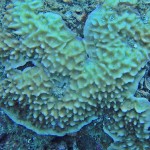The moon brain corals of the family Faviidae have yielded some interesting new species lately, but the newly described Favites monticularis will stand out in your mind, literally. Favia camranensis was certainly neat with its shingle-like corallites but the spiny corallite walls of Favites monticularis definitely take the cake.
Discovered growing at a few locations in the Northern Andaman Islands of Thailand, Favites monticularis superficially looks a lot like Leptoseris mycetoseroides, minus all the cool colors. But upon closer inspection of the structure of the spiny Favites, you can see how this species has developed a very unique spiny appearance which is not replicated in any other species of Faviid.
Favites monticularis is a primarily encrusting slightly massive species with cerioid (slightly oval) corallites. Where the corallite walls meet in F. monticularis they create unusual (for a moon coral) spines that are slightly reminiscent of horn corals of the Hydnophora genus, particularly H. microconos.
It’s funny how coral morphology terminology works; in horn corals the spines are called ‘hydnophores’, in Pocillopora they are called ‘verrucae’, in Montipora they are called ‘tubercules’, but in this species, the spines are called ‘monticules’. There’s probably a reason for the different names for coral spines, probably from how they form or are derived, but it all just adds up to diversity of coral appearance.
Hats off to Tamal Mondal et. al. for describing the new species in the Journal of Threatened Taxa and especially for taking lots of pictures of Favites monticularis alive in the wild so we aquarists can make full appreciation of it.
[singlepic id=10388 w= h= float=none]




